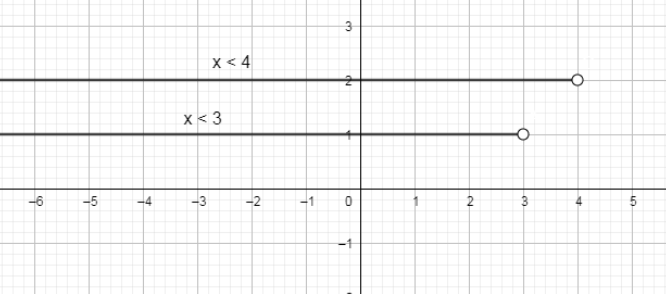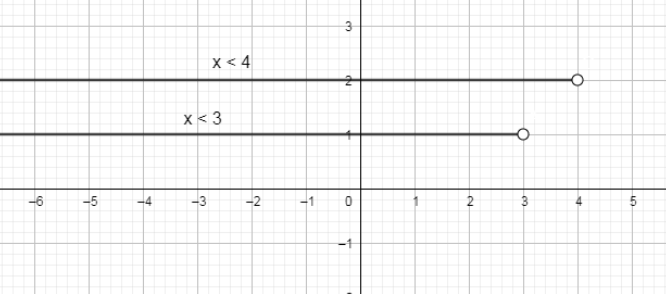
Answer
412.2k+ views
Hint: In the above problem, we are asked to write the inequalities $4 > x\text{ or }3 > x$ in interval notation. We know that if we have given $2 > x$ then the interval notation for this inequality is $x\in \left( -\infty ,2 \right)$ so using this notation we can write the interval notation for $4 > x\text{ or }3 > x$. Also, there is a word “or” in this inequality which means we have to take the union of these two inequalities.
Complete step-by-step solution:
The inequalities given in the above problem is as follows:
$4 > x\text{ or }3 > x$
Now, we are going to write the interval notation for $4 > x$ which is equal to:
$x\in \left( -\infty ,4 \right)$
And then, we are going to write the interval notation for $3 > x$ which is equal to:
$x\in \left( -\infty ,3 \right)$
In the above problem, we have given $4 > x\text{ or }3 > x$, the “or” sign means the union of these two inequalities. So, applying the union in the interval notation for $4 > x\text{ or }3 > x$ we get,
$x\in \left( -\infty ,4 \right)\bigcup x\in \left( -\infty ,3 \right)$
Now, finding the union of the above two intervals by plotting these intervals on the number line.

The union of the two intervals is equal to:
$x\in \left( -\infty ,4 \right)$
Hence, the interval notation for the given inequality is $x\in \left( -\infty ,4 \right)$.
Note: In the above problem, if instead of union, intersection will be given and it will look like:
$4 > x\text{ and }3 > x$
“And” is the common region between the two intervals so the interval notation for the above is as follows:
$x\in \left( -\infty ,4 \right)\bigcap x\in \left( -\infty ,3 \right)$
Now, plotting these two intervals on the number line we get,

As you can see that the common region is $x<3$ and the interval notation for this inequality we get,
$x\in \left( -\infty ,3 \right)$
The difference between union and the intersection is that in union we will take the largest interval just like we have taken in the above solution as $x\in \left( -\infty ,4 \right)$ and the intersection only involve the common region between the two intervals or you can say the smallest interval i.e. $x\in \left( -\infty ,3 \right)$.
Complete step-by-step solution:
The inequalities given in the above problem is as follows:
$4 > x\text{ or }3 > x$
Now, we are going to write the interval notation for $4 > x$ which is equal to:
$x\in \left( -\infty ,4 \right)$
And then, we are going to write the interval notation for $3 > x$ which is equal to:
$x\in \left( -\infty ,3 \right)$
In the above problem, we have given $4 > x\text{ or }3 > x$, the “or” sign means the union of these two inequalities. So, applying the union in the interval notation for $4 > x\text{ or }3 > x$ we get,
$x\in \left( -\infty ,4 \right)\bigcup x\in \left( -\infty ,3 \right)$
Now, finding the union of the above two intervals by plotting these intervals on the number line.

The union of the two intervals is equal to:
$x\in \left( -\infty ,4 \right)$
Hence, the interval notation for the given inequality is $x\in \left( -\infty ,4 \right)$.
Note: In the above problem, if instead of union, intersection will be given and it will look like:
$4 > x\text{ and }3 > x$
“And” is the common region between the two intervals so the interval notation for the above is as follows:
$x\in \left( -\infty ,4 \right)\bigcap x\in \left( -\infty ,3 \right)$
Now, plotting these two intervals on the number line we get,

As you can see that the common region is $x<3$ and the interval notation for this inequality we get,
$x\in \left( -\infty ,3 \right)$
The difference between union and the intersection is that in union we will take the largest interval just like we have taken in the above solution as $x\in \left( -\infty ,4 \right)$ and the intersection only involve the common region between the two intervals or you can say the smallest interval i.e. $x\in \left( -\infty ,3 \right)$.
Recently Updated Pages
How many sigma and pi bonds are present in HCequiv class 11 chemistry CBSE

Mark and label the given geoinformation on the outline class 11 social science CBSE

When people say No pun intended what does that mea class 8 english CBSE

Name the states which share their boundary with Indias class 9 social science CBSE

Give an account of the Northern Plains of India class 9 social science CBSE

Change the following sentences into negative and interrogative class 10 english CBSE

Trending doubts
Fill the blanks with the suitable prepositions 1 The class 9 english CBSE

The Equation xxx + 2 is Satisfied when x is Equal to Class 10 Maths

In Indian rupees 1 trillion is equal to how many c class 8 maths CBSE

Which are the Top 10 Largest Countries of the World?

How do you graph the function fx 4x class 9 maths CBSE

Give 10 examples for herbs , shrubs , climbers , creepers

Difference Between Plant Cell and Animal Cell

Difference between Prokaryotic cell and Eukaryotic class 11 biology CBSE

Why is there a time difference of about 5 hours between class 10 social science CBSE



